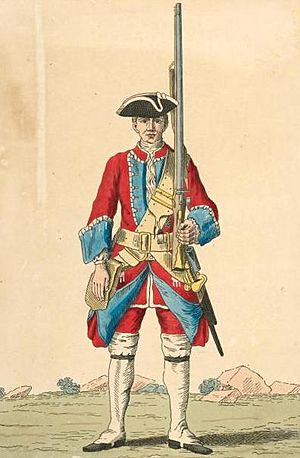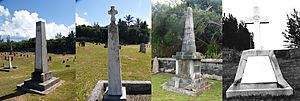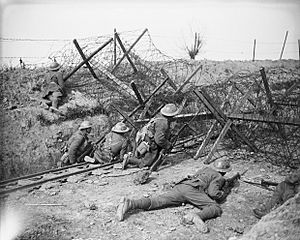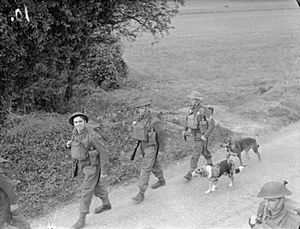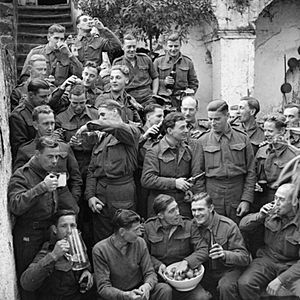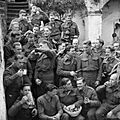Queen's Royal Regiment (West Surrey) facts for kids
Quick facts for kids Queen's (Royal West Surrey) RegimentQueen's Royal Regiment (West Surrey) |
|
|---|---|
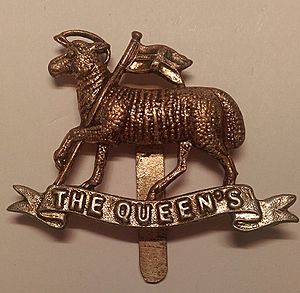
Queen's Royal Regiment (West Surrey) Cap Badge
|
|
| Active | 1661–1959 |
| Country | |
| Branch | |
| Type | Line infantry |
| Role | Infantry |
| Size | 1–2 Regular battalions 1 Militia battalion (2nd Royal Surrey Regiment of Militia) 2 Volunteer and up to 9 Territorial battalions Up to 13 New Army and war service battalions |
| Part of | Home Counties Brigade |
| Garrison/HQ | Stoughton Barracks, Guildford |
| Nickname(s) | Kirke's Lambs, The Mutton Lancers |
| Motto(s) | Pristinae Virtutis Memor (Mindful of Former Valour) Vel Exuviae Triumphans (Even in Defeat Triumphant) |
| March | Quick: We'll Gang Nai Mair to Yon Toon Slow: Scipio |
| Anniversaries | Glorious First of June (1 June) Salerno (9 September) |
The Queen's Royal Regiment (West Surrey) was a famous line infantry regiment in the English and later the British Army. It existed from 1661 to 1959. This regiment was the oldest English line infantry regiment in the British Army. Only the Royal Scots regiment was older among all British Army line infantry.
In 1959, the regiment joined with the East Surrey Regiment. They formed a new regiment called the Queen's Royal Surrey Regiment. Later, in 1966, this new regiment combined with several others. These included the Queen's Own Buffs, The Royal Kent Regiment, the Royal Sussex Regiment, and the Middlesex Regiment (Duke of Cambridge's Own). Together, they created the Queen's Regiment. Even more changes happened in 1992. The Queen's Regiment joined with the Royal Hampshire Regiment. Today, the history of the Queen's Royal Regiment is carried on by the Princess of Wales's Royal Regiment (Queen's and Royal Hampshires).
Contents
How the Regiment Got Its Name

The regiment began in 1661. It was started by Henry Mordaunt, 2nd Earl of Peterborough. At first, it was called The Earl of Peterborough's Regiment of Foot. Its main job was to guard Tangier, a new English territory. Tangier was part of the dowry of Catherine of Braganza when she married King Charles II. Because of this, it was also known as the Tangier Regiment.
Like other regiments at the time, it was often named after its current leader, called a colonel. One of these colonels was Percy Kirke. From him, the regiment got its nickname Kirke's Lambs. The regiment left Tangier when King Charles II gave up the colony.
In 1685, it received a special royal name: The Queen Dowager's Regiment of Foot. This was in honor of Queen Catherine, who was King Charles II's widow. In 1703, its name changed again to The Queen's Royal Regiment of Foot. Then, in 1715, it became The Princess of Wales's Own Regiment of Foot. This was for Caroline of Ansbach, who was then the Princess of Wales. When she became Queen in 1727, the regiment was renamed The Queen's Own Regiment of Foot.
By 1747, it was officially ranked as the 2nd Foot. In 1751, a royal order changed its name to 2nd (The Queen's Royal) Regiment of Foot.
Later, in 1881, during army changes, it became the county regiment for West Surrey. Its new name was The Queen's (Royal West Surrey) Regiment. In 1921, the name was slightly changed to The Queen's Royal Regiment (West Surrey). By 1950, it was simply known as The Queen's Royal Regiment. Finally, in 1959, it merged with the East Surrey Regiment to form the Queen's Royal Surrey Regiment.
Regiment's History
Early Adventures
The regiment sailed to Tangier and stayed there until 1684. After returning to England, it helped stop the Monmouth Rebellion. They fought at the Battle of Sedgemoor. After the Glorious Revolution, the regiment fought in Ireland for the new king, William III. They defended Derry in 1689 and fought at the Battle of the Boyne in 1690.
From 1692 to 1696, they fought in Flanders during the Nine Years' War. They were at the Battle of Landen and helped retake Namur in 1695.
During the War of Spanish Succession, the regiment served in Spain. They fought at Cadiz and Vigo. They also took part in sieges like Valencia de Alcantara and Ciudad Rodrigo. The regiment was almost completely destroyed at the terrible Battle of Almansa. In 1703, they bravely defended Tongres against many enemies. This gave Lord Overkirk time to regroup his forces. For this brave action, the regiment was given its Royal title and mottos. For most of the 1700s, they were on guard duty. They also helped stop the Gordon Riots.
Fighting in the French and Napoleonic Wars
When the French Revolutionary Wars started, some soldiers were in the West Indies. Others served as marines on ships in the Channel Fleet. They were notably at the battle of the Glorious First of June in 1794. They served on Admiral Howe's flagship, Queen Charlotte. They were also on other ships like Russell and Defence. Because of their service, the regiment was allowed to wear a Naval Crown on its flags. This crown had "1 June 1794" written on it.
The regiment then reunited and went to the West Indies. They helped capture Guadeloupe in 1794. However, many soldiers got sick with yellow fever, so they didn't stay long. They also helped capture Trinidad in 1797. A second group of soldiers was formed in 1795. They were sent to Martinique but were later disbanded in 1797. Their soldiers joined the first group.
In 1798, the regiment moved to Ireland. They helped stop the Irish rebellion. Then, in 1800, they were part of an unsuccessful trip to Belle Isle. From there, they sailed to Egypt. They fought in the Battle of Alexandria and the Siege of Alexandria.
During the Napoleonic Wars, the regiment first fought in the Peninsular War. They were at the battles of Vimeiro and Corunna. They then took part in the difficult Walcheren Campaign. After that, they returned to Spain to fight at the Battle of Fuentes de Oñoro. They also fought in the second Siege of Ciudad Rodrigo and the Battle of Salamanca. They also tried to capture Burgos, but it was unsuccessful.
By the winter of 1812, many soldiers were lost due to fighting and sickness. Four companies joined with another weakened group to form the 2nd Provisional Battalion. Six other companies went home to rebuild. This Provisional Battalion was part of 4th Division. They helped Wellington win at the Battle of Vittoria in 1813. They also fought at the Siege of San Sebastián and, in 1814, at the battles of Orthes and Toulouse.
The Victorian Era and Beyond
The regiment was on duty in Baluchistan when the First Afghan War began in 1839. They were part of the force that attacked the strong city of Ghazni. They took the city by storm, even though they lacked siege equipment. This opened the way to Kabul. They returned to India in November 1839, capturing Khelat on the way. They avoided the disaster that happened to other British forces.
In 1851, the regiment sailed to the Cape Colony during the Eighth Xhosa War. On February 25, 1852, a group of 51 soldiers was on HMS Birkenhead. The ship was traveling from Simon's Town to Port Elizabeth when it hit rocks. The soldiers stood in formation on deck. This allowed the women and children to get into the lifeboats safely. Soon after, the ship broke apart. Most of the soldiers drowned or were attacked by sharks. The bravery of these soldiers, from ten different regiments, led to the "Birkenhead Drill" rule.
The regiment became the 1st Battalion again when the 2nd Battalion was reformed in 1857. In 1860, it went to China during the Second Opium War. They fought at the Third Battle of Taku Forts and helped capture Beijing. From 1864 to 1866, they were stationed in Bermuda. During this time, many soldiers died from yellow fever. The battalion lost 52 officers and men to the disease.
Army changes in the 1870s and 1881 did not greatly affect the regiment. It already had two battalions. So, it did not need to merge with another regiment. In 1881, it became The Queen's (Royal West Surrey) Regiment. In 1897–98, one battalion took part in the Tirah Expedition on the North-West Frontier.
The 1st battalion was in Malta from 1891, then in India. The 2nd Battalion fought in the Third Anglo-Burmese War from 1886 to 1888. It also served in South Africa from 1899 to 1904, including during the Second Boer War (1899–1902). From 1912 to 1914, it was in Bermuda. While there, the Edison Studios filmed movies like The Relief of Lucknow. The soldiers from the 2nd Battalion even appeared as extras.
A 3rd Battalion, made of Militia soldiers, was formed in Guildford. This battalion went to South Africa in 1900 for the Second Boer War. They returned in 1902.
Two groups of Volunteer Force soldiers joined the regiment in 1883. These were the 1st Volunteer Battalion (VB) and the 2nd VB. Both groups sent volunteers to serve with the regular soldiers during the Second Boer War.
In 1908, the Militia became the Special Reserve. The Volunteers became part of the Territorial Force (TF). The regiment now had the 3rd Battalion (Special Reserve), the 4th Battalion (TF), and the 5th Battalion (TF).
The First World War (1914-1918)
Regular Army Battalions
The 1st Battalion arrived in France in August 1914. It was part of the 3rd Brigade in the 1st Division. They fought on the Western Front for the entire war. They saw action at the Battle of Mons, the Battle of the Marne, and the Battle of Ypres. They also fought at the Battle of Loos, the Battle of the Somme, and the Battle of Arras.
The 2nd Battalion was in South Africa when the war started. It arrived in Belgium in October 1914. It was part of the 22nd Brigade in the 7th Division. They also fought on the Western Front at the Battle of Ypres and the Battle of the Somme. In November 1917, they moved to the Italian Front. There, they took part in the battles of the Piave and Vittorio Veneto.
Territorial Force Battalions
The 1/4th Battalion went to India in October 1914. It stayed there throughout the war, serving on the North West Frontier. It was also involved in the Third Afghan War in 1919. The 1/5th Battalion also went to India. Later, it moved to Mesopotamia in December 1915.
The 2/4th Battalion served in many places. It fought in the Gallipoli Campaign, in Egypt, and Palestine. Then, it was sent back to the Western Front. It served in the 34th Division and took part in the final advance in November 1918.
New Army Battalions
The Queen's Regiment also formed several 'Kitchener's Army' battalions. These were new groups of soldiers formed for the war.
- 6th (Service) Battalion: Fought on the Western Front.
- 7th (Service) Battalion: Also fought on the Western Front.
- 8th (Service) Battalion: Served on the Western Front.
- 10th (Service) Battalion (Battersea): Formed by the Metropolitan Borough of Battersea. Fought on the Western Front.
- 11th (Service) Battalion (Lambeth): Formed by the Metropolitan Borough of Lambeth. Also fought on the Western Front.
Between the World Wars
The 1st Battalion spent the years between the wars on duty in Britain and overseas. The 2nd Battalion took part in the Waziristan campaign from 1919–1920. They tried to bring peace to tribal areas after the Third Afghan War. It was in Palestine during the Insurgency of 1936–1939.
The 4th and 5th Battalions were reformed in the Territorial Army. However, in the late 1930s, the 4th Queen's was changed to the Royal Artillery. It became the 63rd (Queen's) Searchlight Regiment.
Other London Regiment battalions also joined the Queen's Royal Regiment. These became the 6th (Bermondsey) and 7th (Southwark) battalions. They joined the 5th Battalion in the 131st Brigade.
The Second World War (1939-1945)
The 1st Battalion was in British India when the Second World War began. It started fighting in 1942 against the Imperial Japanese Army. The 1st Queen's fought in the Burma Campaign throughout the war. They were part of the 33rd Indian Infantry Brigade, 7th Indian Infantry Division. This division was part of the British Fourteenth Army.
The 2nd Battalion spent the early war years in the Middle East and Syria. Later, they went to the Far East. They were part of the 16th Brigade. They were involved in Operation Thursday, which was the second Chindits campaign. The Chindits were special forces created by Brigadier Orde Wingate. After many losses in the Chindits campaign, the 2nd Queen's became a regular infantry battalion again. They served with the 29th Infantry Brigade from May 1945.
The 1/5th, 1/6th, and 1/7th were all first-line Territorial Army battalions. They were part of the 131st Infantry Brigade. This brigade was part of the 44th (Home Counties) Infantry Division. The brigade went to France in 1940 to join the British Expeditionary Force (BEF). They were involved in the Battle of France and the Dunkirk evacuation.
After returning to England, the division later went to North Africa in mid-1942. They joined the British Eighth Army. They fought in the Battle of Alam el Halfa and the Second Battle of El Alamein. The 131st Brigade was then assigned to the 7th Armoured Division. They stayed with this division for the rest of the war. The brigade fought in the Tunisian and Italian Campaigns. In December 1944, due to many casualties, the 1/6th and 1/7th Battalions were replaced. The 1/5th Battalion helped in the final weeks of the war towards Hamburg.
The 2/5th, 2/6th, and 2/7th battalions were second-line Territorial Army battalions. They served in the 35th Infantry Brigade. They also went to France in 1940 and were involved in the Battle of Dunkirk. They suffered many losses because the soldiers had little training. The brigade was later renamed the 169th Infantry Brigade. This brigade served with the 56th Division in the Italian Campaign. They fought at Salerno, Anzio, and in the final Allied attack in Italy, Operation Grapeshot.
In January 1944, Lieutenant Alec George Horwood of the 1/6th Battalion received the Victoria Cross. This was for his bravery during the Burma Campaign.
The 63rd (Queen's) Searchlight Regiment helped defend against air attacks during the Battle of Britain and the Blitz. It later became the 127th (Queen's) Light Anti-Aircraft Regiment, Royal Artillery. They used Bofors guns to protect the Mulberry harbour after D-Day. They also defended Antwerp later in the war.
The regiment formed many other battalions during the war. These were mainly for home defense or training. They did not see active combat.
After the War and Merging
The 2nd Battalion was closed down in 1948. Its soldiers joined the 1st Battalion. The 1st Battalion served in Berlin during the blockade until 1949. Then it was in Germany until 1953. The 1st Battalion fought against Communist guerrillas during the Malayan Emergency from 1954 to 1957. In 1957, it returned to Germany. In 1959, it merged with the 1st Battalion, East Surrey Regiment. They formed the 1st Battalion, Queen's Royal Surrey Regiment.
When the Queen's Royal Surreys merged into the new Queen's Regiment, the battalion became the 1st (Queen's Royal Surreys) Battalion. Today, the regiment's history continues with the 1st Battalion, Princess of Wales's Royal Regiment.
Regimental Museum
The Surrey Infantry Museum used to be at Clandon Park House, near Guildford. However, it was destroyed in a fire in April 2015.
Battle Honours
Battle honours are special awards given to military units for their bravery in battles. Here are some of the battles where the Queen's Royal Regiment fought:
- Tangier 1662–80, Namur 1695, Egypt, Vimiera, Corunna, Salamanca, Vittoria, Peninsula, Ghuznee 1839, Khelat, Affghanistan 1839, South Africa 1851-2-3, Taku Forts, Pekin 1860, Burma 1885–87, Tirah, Relief of Ladysmith, South Africa 1899–1902
- The Great War: Mons, Marne 1914 '18, Aisne 1914, Ypres 1914 '17 '18, Battle of Loos, Somme 1916 '18, Arras 1917 '18, Passchendaele, Cambrai 1917 '18, St. Quentin, France and Flanders 1914–18, Piave, Vittorio Veneto, Italy 1917–18, Gallipoli 1915, Egypt 1915–16, Palestine 1917–18, Mesopotamia 1915–18
- Afghanistan 1919
- The Second World War: Defence of Escaut, Villers Bocage, North-West Europe 1940 '44–45, Syria 1941, Sidi Barrani, Tobruk 1941, El Alamein, North Africa 1940–43, Salerno, Monte Stella, Italy 1943–45, North Arakan, Kohima, Burma 1943–45
- 4th, 5th Battalions: South Africa 1900–02
Victoria Cross Heroes
The Victoria Cross is the highest award for bravery in the British military. The following members of the regiment earned this award:
- Lieutenant Wallace Duffield Wright
- Captain Bernard Cyril Freyberg (during the Great War)
- 2nd Lieutenant Clement Robertson (during the Great War)
- Lance Corporal John William Sayer (during the Great War)
- Captain Christopher Bushell (during the Great War)
- Lieutenant Alec George Horwood (during the Second World War)
Images for kids
-
Henry Mordaunt, 2nd Earl of Peterborough, founder of the regiment
-
Infantrymen of the Queen's Royal Regiment (West Surrey) on the march with messenger dogs near Barham, Kent, 13 October 1941.


